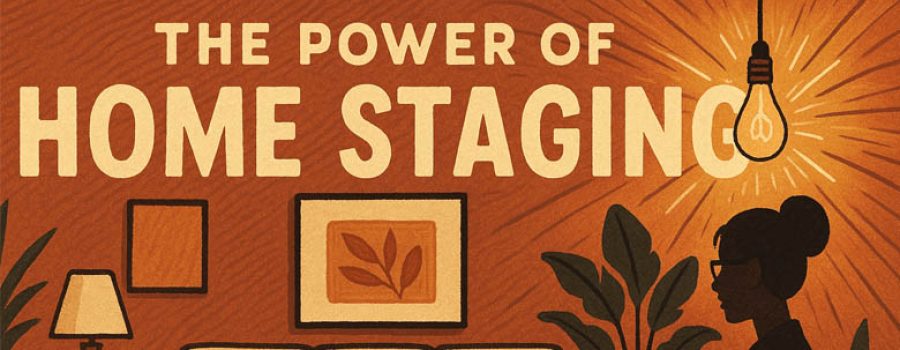I’ve spent 25 years in this industry, and I’ve heard every version of staging skepticism. “Isn’t it just a fad?” “It’s nice-to-have but not necessary.” For years, agents treated staging like an optional luxury you could skip when the market was hot.
Those days are over.
In 2025, staging isn’t just alive and thriving. It’s fueling billion-dollar industries, reshaping how real estate operates, and creating opportunities nobody saw coming. Staging doesn’t just sell homes anymore. It powers an entire economic ecosystem.
Why Staging Actually Works
Let’s start with the basics. The National Association of Realtors has consistently found that over 80% of buyers struggle to visualize a space beyond what they see in front of them. If a home is cluttered, outdated, or sitting empty, most buyers simply can’t picture themselves living there.
Staging solves this problem by creating environments that buyers emotionally connect with. But here’s where most people get it wrong.
For the past 25 years, agents and sellers have thought of staging as decorating. A sofa here, a rug there, maybe some throw pillows. That limited definition never served anyone well, and it’s completely outdated now.
Real staging is an umbrella term for a comprehensive three-step process: making necessary repairs, implementing strategic updates, and creating showcases that forge emotional connections with buyers. When we reduce staging to decorating, we miss its full power. When we embrace it as the strategic discipline it actually is, staging becomes the difference between listing a property and positioning it to win.
The Numbers Don’t Lie
Industry research shows staged homes spend up to 90% less time on the market compared to non-staged properties. Sellers net more money, agents protect their commissions, and buyers feel like they’ve found a home instead of just another house.
Here’s a real example that illustrates the point perfectly. An expired listing originally priced at $649,000 got reduced to $625,000 before the seller decided to bring in a staging consultant. The stager’s consultation fee was $395. Pre-sale improvements totaled $20,000, furniture rentals cost $4,225, and the showcase fee was $2,500. After new comps, the agent relisted the property at $685,000.
It sold the next day for $744,000.
That’s a $95,000 lift from the original listing price and nearly 350% return on the staging investment. The staging fees represented just 0.3% of the final sale price. Numbers like these make staging less of an expense and more of a strategic investment.
But the impact goes far beyond individual transactions.
The Hidden Economic Engine
The economic ripple effects of staging reach much deeper than most people realize. Behind every staged home are entire industries that depend on this business.
Furniture and retail: Stagers purchase millions of dollars in inventory annually, driving demand at retailers like Home Depot, Lowe’s, IKEA, and Wayfair, plus countless boutique wholesalers and local suppliers. The U.S. home décor market alone is worth over $200 billion annually. Home Depot attributes up to 20% of their sales to property preparation projects.
Transportation and logistics: From U-Haul (who reported $4.5 billion in revenue in 2023) to Penske and Ryder, staging businesses represent steady customers renting and buying trucks. Larger staging firms even invest in their own branded fleets.
Storage services: The U.S. self-storage industry is valued at over $35 billion, with Canada adding nearly $6 billion more. Staging companies lease warehouses and climate-controlled units to house their inventory.
Insurance: Liability and inventory coverage are mandatory for staging companies. Insurance providers have developed policies specifically for stagers, creating revenue from an industry that barely existed 20 years ago.
Technology: Tools like Matterport for 3D tours and BoxBrownie for photo editing wouldn’t have gained traction without staging raising the bar for listing presentation standards.
Remove staging from the equation, and you’d see losses ripple across retail, logistics, insurance, technology, and storage industries.
The Services Staging Created
Staging’s influence extends beyond boosting existing industries. It has sparked entirely new ones.
Furniture rental businesses that exist solely to serve stagers. **Specialized logistics and moving services** where “two men and a truck” operators rely on staging companies as repeat customers. **Professional real estate photography and videography** became standard because staging raised expectations for listing visuals.
Home improvement and pre-sale prep services now market specifically to stagers and sellers preparing properties for market. Painters, flooring installers, landscapers, and contractors have built entire business models around this demand.
Pay-at-close concierge programs have revolutionized the industry. Brokerages like Compass Concierge, Redfin Concierge, and Keller Williams’ Ready-to-Sell program have turned staging and pre-sale prep into packaged services that sellers now expect. Companies like Titus, Noteable, and Curbio have raised hundreds of millions to scale these services nationwide.
Training and certification programs emerged to professionalize the industry. CSP International™ set the benchmark for training and standards, while associations like IAHSP and RESA provide platforms for networking, advocacy, and industry growth.
Even legal and administrative services expanded as staging became standard practice, handling contracts, insurance, disclosures, and administrative needs.
What does this mean for real estate agents? Every time a home gets staged, it supports retailers, movers, storage facilities, contractors, cleaners, and dozens of small businesses. Behind every staged room are real livelihoods: delivery crews, photographers, stylists, tradespeople, and entrepreneurs.
Skipping staging doesn’t just affect one sale. It ripples outward, affecting people’s work, families, and the economic strength of your marketplace.
The Pay-at-Close Revolution
One of the clearest signs that staging has evolved from optional extra to essential strategy is the rise of pay-at-close concierge programs.
Major brokerages now front the costs of staging and improvements, recouping their investment after the sale closes. This isn’t just convenience; it’s strategy. These programs remove the biggest barrier for sellers (cash upfront) while proving that brokerages have studied the data and know staging directly drives higher returns.
More importantly, it resets seller expectations. Clients now assume their agent will provide a comprehensive solution, not just list their property and hope for the best.
Agents and brokerages that don’t embrace these full-service models risk making themselves obsolete. The industry has moved toward comprehensive transformation, and pay-at-close programs are the bridge making it mainstream.
The Virtual Staging Trap
For every proven strategy, there’s always a shortcut that promises results without the work. In staging, that shortcut is virtual staging.
On the surface, it looks appealing. A few clicks and empty rooms appear beautifully furnished online. It seems fast, cheap, and easy. But digital illusions don’t sell homes.
Buyers walk through the door expecting one thing and finding another. Instead of building trust, virtual staging creates disappointment and frustration. It’s like a dating app profile that promises one thing and delivers something completely different.
This matters because nearly 80% of buying decisions are emotional. When buyers experience disappointment, their brains don’t just reset and move on. They remember. An unappealing carpet might cost $2,000 to replace, but disappointed buyers mentally deduct $10,000 from the home’s perceived value.
Real staging prevents this spiral by addressing objections before they arise.
Virtual staging also puts agent reputations at risk. Sellers notice when corners get cut. They might not say it aloud, but they’re thinking: “If my agent can’t market my home properly, maybe they’re not the professional I need.”
There’s an economic cost too. Real staging fuels jobs across multiple industries. Virtual staging erases that ecosystem entirely. What looks like a cheap solution for one listing actually chips away at the very industries that staging built.
Real staging builds trust and connection. Virtual staging leaves buyers swiping left.
Looking Forward
Staging is only becoming more embedded in real estate. Sustainability trends are driving demand for eco-friendly furniture and reusable inventory. Technology firms are exploring AI for layout optimization and enhanced virtual experiences. Even lenders and insurers are beginning to recognize staging’s role in property valuation.
The question isn’t whether staging will survive. It’s what happens when buyers expect every listing to be professionally staged. At that point, agents who haven’t embraced staging won’t just be behind the curve. They’ll be invisible.
Staging is no longer an option. It’s the baseline for professional real estate marketing in 2025.
Pioneer’s Perspective
When I wrote Home Staging for Dummies, staging was still seen as a sideline service. That’s why I launched CSP International™ in 2005 – to establish the standards and professional framework the industry desperately needed.
Thousands of graduates later, I’ve watched their businesses fuel industries from retail to logistics, proving that staging isn’t just décor. It’s an economic driver that creates real value for everyone involved.
What started with a single book became a professional movement that benefits homeowners, agents, and entire industries. Looking back, I’m proud that so many people trusted us in those early days to help raise the bar and set standards that transformed staging from a “nice idea” into a recognized profession.
The Reality Check
If you’re still wondering whether staging matters in 2025, you’re asking the wrong question. Staging doesn’t just matter anymore. It’s defining the market.
Agents who understand and leverage staging properly will thrive. Those who ignore it risk being left behind by an industry that has already moved forward without them.
The market has spoken. The data is clear. The economic impact is undeniable.
Staging isn’t a trend. It’s the foundation of modern real estate marketing, and it’s here to stay.














 Subscribe Today!
Subscribe Today! 


